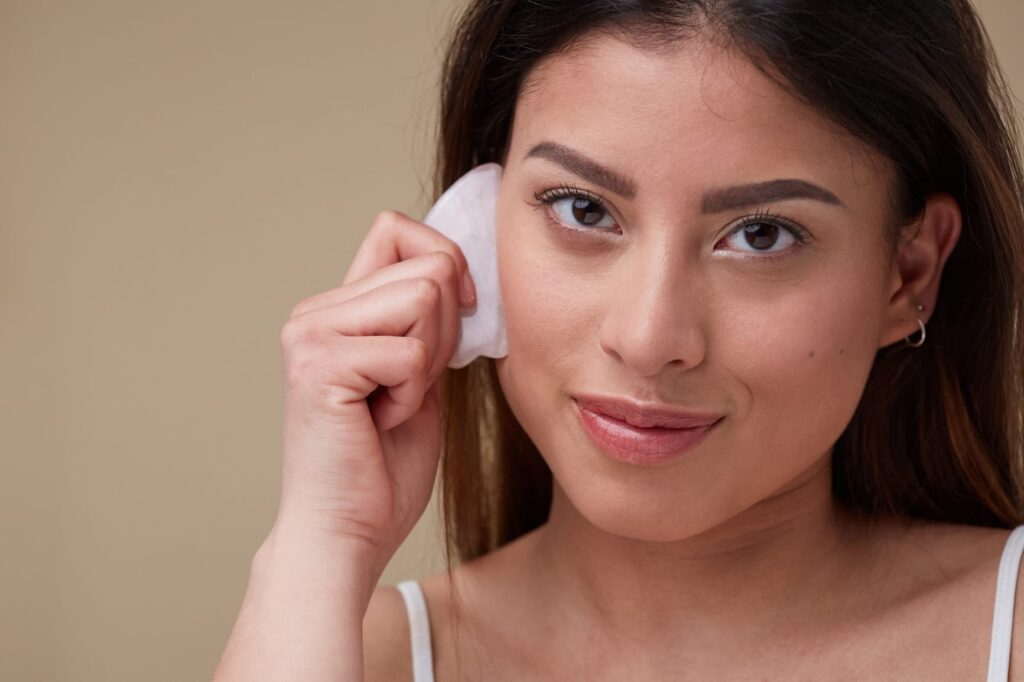The steps for a skin care routine are explained in this post. Actually, it’s not as difficult as it might sound. You may start treating common skin disorders like acne, hyperpigmentation, dryness, and soreness by including the right skin care into your program and condensing your daily tasks into a few quick (but essential!) acts. This will leave your skin gleaming.
Visualize healthy skin. The image in your head is probably well hydrated, evenly toned, and reflecting light from all directions if the approximately 11 million Instagram photos that use the hashtag are any indication. But with so many products available—really, so many—how can you get the complexion that Instagram demonstrates is done every day?
Here are some information about the steps in this article’s skin care routine:
Use sunscreen to shield yourself from UV rays
It’s essential to apply sunblock every day before heading outside for additional protection. If you’re going to be spending time in the sun, choose a sunblock with an SPF of 30 or higher and make sure to reapply it every two hours.
Here’s a brief overview of the two main types of sun protection available today in case you’re unclear about which sunscreen to choose.
Physical obstructions: Ingredients like zinc oxide or titanium dioxide are found in sunblock. Imagine them as an umbrella: To prevent UV rays from penetrating your skin, they rest on top of it. While this may seem ideal, many of these products tend to feel a little milky or leave a white cast on the skin.
Chemical deterrents: On the other hand, sunscreens are supposed to absorb into the skin and help block out rays by causing a chain reaction that releases heat. Consider these activities as a sponge that helps you deal with the sun’s rays on your skin. If you decide to use a chemical blocker, look for the ingredients avobenzone, octinoxate, octocrylene, and octisalate on the bundle.
Use a mask on your skin at night.
Try wearing a face mask while you sleep to give your skin an extra burst of hydration. You can add hydration, brightening agents, or acne fighters as a supplement, depending on your skin type and its needs. Examine facial masking as well.
Place a liberal amount on your skin just before bed, and leave it there all night. To get rid of any leftover residue that may have gotten into wrinkles or deep lines, wash your skin with warm water in the morning.
Use a serum to meet the needs of your skin.
Because serums contain the most concentrated “active ingredients,” or the kinds of compounds in products that help you actually see results, they tend to be the most effective phase in your process. You might want to look for products that contain the ingredients listed below depending on what issues you have with your skin:
Retinol: A vitamin A derivative that can help reduce fine lines and wrinkles is the skin specialists’ most researched and recommended ingredient. It is renowned for turning on the skin’s collagen pumps, which help to reduce fine lines and wrinkles. Additionally, retinol accelerates skin cell turnover, helping to quickly clear up acne and dull skin. There are several varieties of retinol, yet some people find it drying. Observe olive skin as well.
Hyaluronic acid, often known as HA, is a humectant that naturally exists in your skin and is known for holding up to 100 times its weight in water. HA depletes over a person’s lifespan, so using it topically as a hydration supplement may be useful. To give your skin the best amount of hydration and plumping, look for a serum with different weights of HA particles because they will sit at different levels of the skin’s structure.
One of the most potent antioxidants available, vitamin C helps to ward against free radicals or unbound electrons that scavenge and harm the skin in a variety of ways. Your skin can become more radiant, and damage caused over time can be repaired by including a topical vitamin C product in your skin care regimen.
Apply a Minimalist Moisturizer
You’ll want to use a mild cream to moisturize your complexion after exfoliating your skin and applying a serum. Look for things that claim they are a gel or milk on the plan because certain moisturizers can feel thick or heavy. Here are some common ingredients to watch out for:
The majority of the skin barrier is made up of ceramides, but when your skin dries out, it may become compromised. You can strengthen your skin barrier and help it retain moisture over time by replenishing them topically.
Glycerin: Glycerin works as a humectant to draw moisture considerably deeper into the skin. Look for this ingredient on the label of skin care products if you want to make sure that your skin is always moisturized.
Squalane: One of the fantastic multi-tasking active ingredients, squalane works as an antioxidant to help lessen the impacts of free radicals while also rehydrating the skin. If you’re looking for a component that can do it all, look for it in your moisturizer.
Use a mild cleanser on your skin and pat it dry.
Many dermatologists advise cleansing your skin twice a day—once in the morning when you wake up and once in the evening before bed. You should look for a light cleanser that doesn’t rely on the soap as its primary ingredient but instead uses softer surfactants, which are cleaning agents that are, for example, derived from coconuts.
Your skin type and how you want your skin to feel after washing determine the best cleanser for you. Acne sufferers may wish to pick up a cleanser that contains salicylic acid or benzoyl peroxide, which has been found in tests to be effective in treating breakouts. For people with oily skin, gel or light, foamy cleansers are frequently excellent choices since they contain more surfactants, which can help break through oil, sweat, and debris in a single wash.
People with sensitive skin should use a micellar cleanser, which draws in oil and grime and uses micelles to remove it from the skin, avoiding harsh washing agents. A velvety or oil-based cleanser, which removes debris and grime from the face while rehydrating it, is typically beneficial for those with dry skin.
Once you’ve chosen the best cleanser for your skin type, apply a quarter-sized amount to your skin and thoroughly wash it off with lukewarm water for 30 to 60 seconds. Following that, make sure all of the product has been removed, and this is crucial, pat your skin dry with a towel. Your skin barrier may be harmed or interfered with if you rub it with an abrasive material, which could lead to future issues for you.
Scrub Your Skin to Get Rid of Dead Cells
One of the most crucial things you can do for healthy, radiant skin is exfoliating. Dead skin cells that build up on the surface of your skin create a barrier that prevents the substances in your products from fully penetrating the skin to perform their function. You can get more use out of the products you buy by getting rid of these dead skin cells because the products will penetrate much deeper and reach skin cells that are still active.
Physical and chemical exfoliation are the two main types:
Exfoliants that use physical force to manually remove dead skin cells include scrubs, brushes, and maybe wet washcloths.
Chemical exfoliants, such as alpha-hydroxy acids, beta-hydroxy acids, or enzymes, help to break down the glue holding the top layer of skin cells together so that they can wash away and dissolve.
Conclusion
Even while it might seem difficult to wake up every morning with glowing skin, it is possible with a focused but simple regimen. Consistency is the key to any routine, so commit to a skin care program to see how it changes your skin tone over time.
Also, keep in mind that your lifestyle has a huge impact on how your skin looks, so try to reduce stress, cut out foods like sugar that induce edoema, and go for walks outside to get your blood flowing. You’ll get that #glowingskin in no time.







Discussion about this post